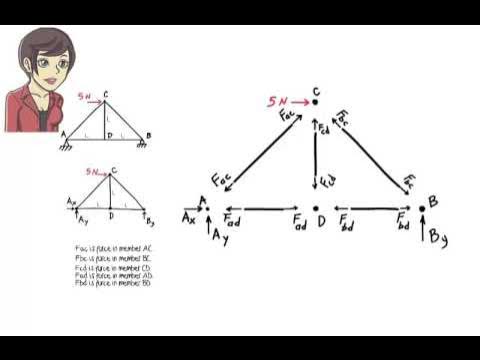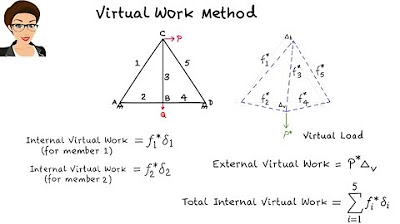Pembahasan Soal Analisis Struktur Truss dengan metode joint/sambungan
Summary
TLDRThis video tutorial explains the process of analyzing forces in a truss structure using the joint method. The speaker covers the steps to determine reactions at the supports, calculate forces in each bar, and identify whether they are under tension or compression. Through a detailed example, the analysis begins with calculating reactions at the supports using equilibrium equations, followed by evaluating forces at each joint. The speaker highlights the significance of equilibrium conditions and the application of Newton's laws in structural analysis, providing a comprehensive guide for solving truss problems.
Takeaways
- 😀 The script introduces the method of joints for analyzing forces in a truss structure.
- 😀 The given problem involves an external load of 1.92 kN acting vertically downward at point A.
- 😀 The structure is supported by a roller at point B (reaction only in one direction) and a pin at point C (reaction in both horizontal and vertical directions).
- 😀 Assumptions include external forces acting only at joints and the weight of bars being evenly distributed between their ends.
- 😀 The first step in analysis is calculating the reactions at the supports using equilibrium equations.
- 😀 Sigma moments (ΣM = 0) and ΣF_x = 0, ΣF_y = 0 are used to determine reactions at supports.
- 😀 The reaction at point B (FB) is found to be 3200 N upwards, while the reaction at point C (CEy) is 1280 N downwards.
- 😀 Forces in the bars are analyzed using static equilibrium principles, and the direction of the forces is determined geometrically.
- 😀 The force in bar AB (F_AB) is calculated to be 4000 N and is under compression.
- 😀 The force in bar BC (F_BC) is calculated to be 2400 N and is under tension.
- 😀 The force in bar AC (F_AC) is calculated to be 1600 N and is under tension.
- 😀 Tension or compression in the bars is determined based on whether the force pulls away from or pushes toward the joints.
Q & A
What is the primary method used for solving the problem discussed in the script?
-The primary method discussed in the script is the 'joint method' (metode sambungan) for determining the forces in each member of a structure.
What are the assumptions made when using the joint method for analysis?
-The two main assumptions are: (1) external forces act only at the joints or ends of the members, and (2) the weight of each member is assumed to be evenly distributed between its two ends.
How does the script describe the first step in using the joint method?
-The first step is to determine the reactions at the supports of the structure. This is done by considering the structure as a rigid body and applying equilibrium equations.
What equilibrium equations are used to analyze the structure?
-The equilibrium equations used are: ΣM = 0 (for moments) and ΣF = 0 (for forces). These equations are used to find unknown forces and reactions in the structure.
How are the reactions at the supports determined in the example given?
-Reactions are determined by taking moments about various points, such as point B or point C, and applying the equilibrium equations to solve for the forces at the supports.
What does a positive or negative sign for the reaction forces indicate?
-A positive value indicates the direction of the reaction is as assumed, while a negative value indicates the actual direction is opposite to the assumed direction.
What role does the Pythagorean theorem play in the analysis?
-The Pythagorean theorem is used to calculate the lengths of the members of the structure, which are needed to break down the forces into components along the x and y axes.
What is the significance of the signs when determining whether forces are tensile or compressive?
-The sign indicates the direction of the force. A positive force implies tension (pulling away from the joint), while a negative force implies compression (pushing toward the joint).
How is the direction of force in each member of the structure determined?
-The direction of force is determined by using the equilibrium of the structure. The forces are assumed based on the reaction forces, and the direction is adjusted according to the conditions of equilibrium.
What is the final step in the analysis for determining the type of force (tension or compression) in each member?
-The final step is to observe the direction of the force in each member. If the force is directed away from the joint, it is tensile; if it is directed toward the joint, it is compressive.
Outlines

This section is available to paid users only. Please upgrade to access this part.
Upgrade NowMindmap

This section is available to paid users only. Please upgrade to access this part.
Upgrade NowKeywords

This section is available to paid users only. Please upgrade to access this part.
Upgrade NowHighlights

This section is available to paid users only. Please upgrade to access this part.
Upgrade NowTranscripts

This section is available to paid users only. Please upgrade to access this part.
Upgrade NowBrowse More Related Video

SA04: Truss Analysis: Method of Joints

V11.1 Statis Tak Tentu - Force Method untuk Truss System

Contoh Perhitungan Rangka Batang dengan Metode Potongan | Analisa Struktur Rangka Batang

S21A- STATIKA PORTAL 3 SENDI- REAKSI PERLETAKAN

SA21: Virtual Work Method (Trusses)

Pembukaan Awal Struktur Rangka Batang
5.0 / 5 (0 votes)